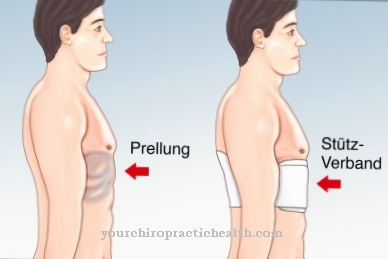A Shoulder dislocation or. Shoulder dislocation is the displacement of the bone parts in the shoulder joint. The bones may have slipped out of the joint only partially or completely. The shoulder dislocation must be treated as soon as possible.
What is a shoulder dislocation?
Under one Shoulder dislocation (shoulder dislocation) one understands a displacement of the bones involved in the shoulder joint, so that the joint is disturbed in its normal mobility. The shoulder joint is one of the largest joints in the body and is one of the ball and socket joints.
The spherical head of the humerus lies in the very small socket on the shoulder blade. Since this bony connection does not provide sufficient stability, the shoulder joint is also held in place by a joint capsule, muscles, tendons and ligaments. With a shoulder dislocation, the head of the humerus partially shifts or jumps completely out of the joint socket.
It can also tear ligaments, damage muscles, and crush nerves and blood vessels. A distinction is made between traumatic shoulder dislocation, which occurs as a result of external force, and atraumatic shoulder dislocation, in which the joint bones shift with simple movements due to slack ligaments.
causes
In a traumatic one Shoulder dislocation an external force on the joint causes the dislocation. This often happens in ball games when, for example, two field players collide with their shoulders or when the athlete falls and falls on his shoulder.
A shoulder dislocation can also occur in sports such as judo, in which twisting and pulling movements of the arm occur. After an initial dislocation, further dislocations can occur if the holding apparatus has already worn out as a result of the first displacement or the dislocation could not heal properly. Here one speaks of habitual (habitual) shoulder dislocation. It can be triggered by vigorously shaking hands.
An atraumatic shoulder dislocation is usually triggered by congenital causes. This can be a congenital slackness of the ligaments or a misalignment of the joint socket (acetabular dysplasia). Various genetic diseases, such as Down's syndrome, have a very elastic, rubber-like capsule tissue around the joints as an accompanying symptom. This makes them unstable and a shoulder dislocation can happen without any force during normal simple movements.
Symptoms, ailments & signs
A shoulder dislocation can result from unfamiliar movement or strain. This clinical picture is of course characterized by typical symptoms and signs that those affected often perceive as very painful. A very clear symptom of a shoulder dislocation is a prolonged feeling of stiffness.
Even with the smallest movements, the affected person perceives severe pain. Therefore, there is a significant restriction in everyday life. In many cases, the affected area becomes very warm because muscles and tendons are inflamed. Many affected people adopt a relieving posture due to the shoulder dislocation, which leads to tension.
Anyone who leaves such a shoulder dislocation entirely without medical care must expect the existing symptoms to worsen considerably. The pain increases so that it can occur even at rest. Due to the posture just described, inflammation in the joints can occur. Under certain circumstances, there is even a risk of permanent consequential damage, so a visit to the doctor is essential.
A shoulder dislocation is characterized by fairly clear and typical symptoms, so that affected people can diagnose a shoulder dislocation themselves. Anyone who refrains from appropriate treatment at this point must expect a significant worsening of the individual symptoms. Otherwise a timely and complete recovery cannot be guaranteed.
Diagnosis & course

A Shoulder dislocation immediately causes severe pain. The arm can no longer be moved, partly because of the pain and partly because the joint has lost its functionality. If nerves are also squeezed by the shoulder dislocation, it can lead to numbness.
Blood vessels can also be pinched by the displaced bones, which leads to circulatory disorders. Going to the doctor is inevitable, as the patient can no longer push the bone back into its normal position. Due to the changed contour of the joint, the doctor will already recognize that there is a shoulder dislocation. A physical examination and mobility testing are usually not possible as this would lead to severe pain.
Usually the arm muscles of the patient are very tense in order to keep the arm in the existing position and to avoid any painful movement. With an X-ray, the doctor can clearly see the shoulder dislocation and also see whether there are any bony injuries.
Complications
A shoulder dislocation is often accompanied by swelling or a bruise, which can become infected if not properly hygienic. As a result of the limited mobility of the joint, those affected often keep their arm in a relieving position - malpositions and joint wear can result. With a simultaneous nerve injury, failures and other problems with the sensation of the lateral shoulder can occur.
Injuries to the arteries are associated with a reduced blood flow in the affected areas and thus cause symptoms of paralysis. The tendon tear on the shoulder that often accompanies it can weaken the flexion of the forearm, which can lead to further pain and movement restrictions, which in some cases are chronic. In addition, a shoulder dislocation can be associated with the so-called Bankart lesion, in which the joint lip is partially torn off.
This can result in chronic dislocation of the shoulder. Surgical treatment of a shoulder dislocation also carries risks. Nerve damage or inflammation can occur. Prescribed painkillers may cause side effects or interactions. If the sport is restarted too early, the shoulder can be dislocated again and must then be treated again.
When should you go to the doctor?
If a stubborn shoulder dislocation occurs, the affected person should see a doctor. A shoulder dislocation can have unpleasant long-term consequences without professional clarification. In addition, the pain is usually difficult to bear.
In order to avoid long-term effects, the treatment and clarification of the dislocation should be carried out by a specialist. The best contact person is the orthopedic surgeon.
Treatment & Therapy
A Shoulder dislocation must be adjusted as soon as possible. Care must be taken to ensure that no surrounding structures are injured during reduction.
Since this treatment only causes severe pain for a short time, the patient is usually lightly sedated and given painkillers for a reduction. In some cases, a brief general anesthetic is also used. After the adjustment, a check is made to ensure that all of the surrounding ligaments, tendons, muscles, nerves and vessels are functional and undamaged. The arm must then be immobilized for a while. Decongestant, anti-inflammatory and pain-relieving drugs are usually administered to support the healing of the affected tissue.
If surrounding structures have been injured by the shoulder dislocation, an operative intervention is necessary. Torn ligaments and tendons are sewn, broken bones are removed or, if possible, put back together again. Finally, after a successfully treated shoulder dislocation, physiotherapy exercises are necessary in order to restore the full functionality of the joint.
prevention
One can Shoulder dislocation only limited prevention. If you already know that you have slack ligaments or if a shoulder dislocation has already occurred, you should especially not practice ball and contact sports. Overall, activities should be avoided that place particular stress on the shoulder.
Aftercare
The aftercare of a shoulder dislocation, like the therapy, is based on the causes of the suffering. After an operation, rest and take care of yourself. The affected arm should be immobilized for three to six weeks. During this period mainly physiotherapy takes place.
The doctor performs passive mobilization, i.e. a movement of the shoulder from the outside. If there are no complications, treatment can be completed after a final physical examination and consultation with the patient. The anamnesis includes working on a catalog of questions to determine whether the shoulder dislocation has completely subsided.
Physiotherapy must be restarted in the event of complications and persistent symptoms. If necessary, other specialists and sports medicine specialists must be involved in the treatment. The orthopedic surgeon or general practitioner usually takes care of the aftercare. It takes place three to six weeks after the last treatment, depending on the course of the symptoms.
Further follow-up examinations are usually not necessary. However, the causes of the shoulder dislocation need to be addressed. Often there is an underlying disease that needs to be clarified. Follow-up care for the causative disease depends on the type of condition and the course of the disease and is discussed with the responsible doctor.
You can do that yourself
In the case of a shoulder dislocation, immobilization and avoidance of heavy loads are particularly recommended. Crates of drinks and other heavy objects should not be lifted for six weeks. Those affected have to refrain from doing sports such as swimming or gymnastics for a while. They often lead to an increase in the symptoms.
Ice compresses help acutely. They relieve pain and inflammation in the first few days. Then heat packs are suitable. They help relax a cramped muscle. If the pain becomes too severe for you, you can use freely available drugs. Aspirin and ibuprofen promise relief, but should only be taken for a short time.
A doctor orders physiotherapy with several units. Exercises are taught in the sessions. You should fully develop the range of motion of the shoulder again. In order to achieve sustainable results, short and regular units must be integrated into everyday life. It is also advisable to continue for a period after physiotherapy. Because strengthening the shoulder muscles is the best way to prevent a new dislocation. If people are prone to a shoulder dislocation, a training plan should be drawn up with the physiotherapist.

.jpg)

.jpg)

.jpg)







.jpg)

.jpg)
.jpg)











.jpg)